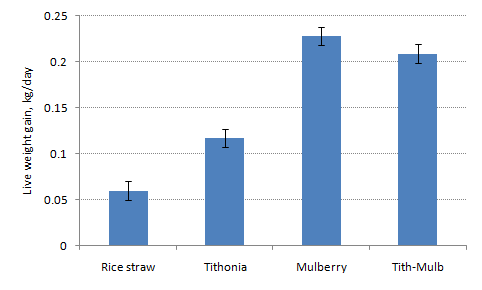 |
|
| Figure 1. Effect of Tithonia diversifolia and mulberry on live weight gain of Yellow cattle fed a basal diet of rice straw plus rumen supplement | |
|
MEKARN Conference 2010 |
These two experiments were curried out on station at the Livestock Research Centre, NAFRI, MAF in Vientiane, Laos.
Experiment I: was arranged in a Randomized complete block design (RCBD) with two treatments and 9 replications. Mulberry and Tithonia foliages were cultivated in monoculture for 19 plots and each plot is 3x6 m (18 m2). The experiment consists of the following two treatments:
MB: harvesting of Mulberry at 45, 60 and 75 days of age.
TN: harvesting of Tithonia at 45, 60 and 75 days of age.
The purpose of this study to investigate the yield and chemical composition of Mulberry and Tithonia foliages and assessing their potential values as a protein source supplement in growing yellow cattle.
It is concluded that different initial ages of harvesting was significantly effected on fresh Mulberry and Tithonia foliage yield as shown (5.0, 6.5, 9.5 and 5.8, 7.9, 10.8 tonnes/ha for harvesting at 45, 60 and 75 days of age, respectively). Furthermore, it was also affected on chemical composition of these foliages. When foliages were harvested at younger age (45 days) had high CP and low NDF content (CP 23 to 25% and NDF 30 to 31% as compared with (75 days) CP about 18 to 19% and NDF 39 to 40%. Mulberry and Tithonia have potential as a good quality local by-pass protein source supplement for ruminant in particularly during the dry season and it help to increase cattle production in term of new appropriate feeding technology in small-holder farms situation.
Experiment II: Four male local cattle were assigned in a 4*4 Latin square design which consisted of 4 replications and 4 treatments. The treatments were: RS: The basal diet of rice straw and rumen supplement. TRS: RS + fresh Tithonia foliage at 1% of LW. MRS: RS + fresh Mulberry foliage at 1% of LW (DM basis). MTRS: RS + Tithonia at 0.5% of LW and Mulberry at 0.5% of LW (both on DM basis). This trial was investigated the effect of fresh Mulberry and Tithonia supplementation on feed intake, digestibility and rumen ecology in growing yellow cattle.
It was found that supplementation of fresh Mulberry and Tithonia leaves were significantly increased feed intake, digestibility and improved rumen ecology in growing cattle when compare to offered only rice straw alone as treatment (RS). Moreover, the treatment (MRS) was significantly highest total DM intake in term of percentage of body weight among the supplemented groups and about (2.8, 2.9, 3.2 and 3.0% for treatment RS, TRS, MRS and MTRS, respectively). Mulberry and Tithonia foliage is an important by-pass protein source supplement for ruminant and help to improve rumen ecology in term of increasing the level of NH3-N (mg%) and total VFA (mM) in the rumen (9.0, 13.1, 15.9, 16.5 mg% and 94.5, 106.4, 108.7, 111.6 mM) for treatment RS, TRS, MRS and MTRS, respectively. However, the results from this trial found that Mulberry leaf is higher palatability than Tithonia leaf.
 |
|
| Figure 1. Effect of Tithonia diversifolia and mulberry on live weight gain of Yellow cattle fed a basal diet of rice straw plus rumen supplement | |